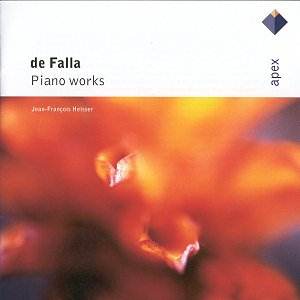It
is often said, if rather unkindly, that the best Spanish music
has been written by Frenchmen. While it is true that Bizet, Debussy
and Ravel composed some of their most wonderful works with Spanish
themes in mind, the Spanish composers themselves can be equally
distinctive. Notable among these masters is Manuel de Falla, who
spent some of the most important years of his career living in
Paris, as some of the pieces collected here testify.
Although
piano music played a less significant part in Falla’s life than
it did for his great contemporaries, Granados and Albéniz,
this intriguing CD compilation has many riches to offer. The list
of repertoire reveals that the best known pieces on the programme
are both transcriptions of great ballet scores: The Three-Cornered
Hat and Love the Magician. On the other hand, the music is so
strong that it retains its essential character in the composer’s
own piano transcriptions. As well as the obvious priority of bringing
the music to a wider public, Falla’s intentions were in the direction
of clarity of tone and style. There is no question that both these
pieces succeed on these terms. That this should be so relies a
great deal, of course, on the clear-textured articulation of Jean-François
Heisser’s playing, and to the clarity of the recorded sound (the
original issue was by Erato). If anything, the somewhat dry acoustic
favours Falla’s cause.
Commissioned
by Artur Rubinstein and first performed in New York in 1920, the
Fantasia Bética lays claim to the accolade of being Falla’s
finest piano piece. In this magnificent, but most subtle, piece,
the spirit of Spain achieves a universal expression. Bétique
was the Roan name for Andalucia, hence the title. Within a single
span lasting a quarter of an hour, the work contains a wide range
of experience, demanding much of the pianist’s technique and more
still of his imagination. At one extreme lies violent energy,
at the other a dreamy idyll. In Heisser’s performance the former
challenge scores particularly strongly, but but does find scope
for the poetic aspect to emerge too.
The
various Spanish pieces, complete with regional descriptions (including
Cuba!), were dedicated to Albéniz, and they certainly sound
more distinctively and deliberately Spanish than the remainder
of this recital. The music is none the worse for that, of course,
since this is an idiom that suits the piano admirably. The popular
rhythms and tunes are eagerly communicated by Heisser, while the
impressionistic subtleties (all the pieces end pp) emerge also
Precursors
of this style are the Obras de Juventud (Three Pieces from my
Youth), which Falla completed in 1889, some time before his mature
personality developed. The piano writing is already assured, particularly
since heisser affords the music due care and attention.
French
influences lie behind the two ‘Hommage’ pieces, dedicated to fellow
composers whom Falla knew and admired. Quoting from Debussy’s
Spanish piano pieces in the Préludes, this Homenaje was
originally written for the guitar, though Falla transferred it
successfully enough to the piano. The Homenaje ‘Pour le tombeau
de Paul Dukas’ is another deeply felt miniature, a sensitive tribute
to a musician to whom Falla felt he owed so much.
With
clear recorded sound and and dedicated performances, this Falla
collection has much to commend it.
Terry
Barfoot
see
also review by Paul
Shoesmith
